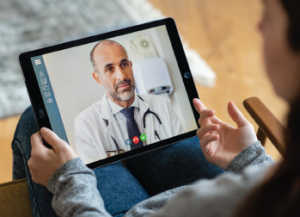
© Rido / shutterstock.com
Until March 2020, telemedicine champion Melissa A. Pynnonen, MD, a professor of otolaryngology at University of Michigan Health in Ann Arbor, had a hard time convincing her department colleagues to use the technology. Some expressed interest; most were reluctant. A few flat-out refused to forego face-to-face encounters.
Explore This Issue
July 2020COVID-19 changed all that.
In February, Michigan Medicine conducted a total of 400 real-time, audio/video visits with the physician and the patient in different locations. That number jumped to 3,000 video visits during the first four weeks of March, and another 3,000 video visits were scheduled for the first week of April alone.
“With the COVID-19 pandemic, providers have been very quick to adopt telehealth and adapt their practices,” said Dr. Pynnonen. “Certainly, in many instances telehealth isn’t a perfect substitution, but during a crisis like this, it’s a wonderful technology that helps us remain connected with our patients.”
As the global pandemic disrupts healthcare services across the globe, a temporary loosening of federal regulations and expanded reimbursement has lifted a number of barriers, encouraging more physicians to try the technology. As of this writing, the Centers for Medicare & Medicaid Services (CMS) allows telehealth visits anywhere in the U.S., with providers and patients able to connect via phone, smartphone, or laptop. Physicians can even use Apple FaceTime, Facebook Messenger, Skype, or Zoom “to provide telehealth without risk that (the Office of Civil Rights) might impose penalties for HIPAA noncompliance,” according to a March 30 memo from the U.S. Department of Health and Human Services. CMS even rolled back rules against practicing across state lines. This means that practices can engage in telemedicine without initially getting involved in a lengthy vendor search, even with electronic medical records (EMR).
“We commend Congress for recognizing the power of telehealth,” Ann Mond Johnson, chief executive officer of the American Telemedicine Association (ATA), said in a March 27 statement. “The telehealth provisions in the CARES Act build on the initial Medicare telehealth waiver authorized by Congress.”
Reimbursement, one of the biggest obstacles to telehealth adoption, according to the ATA, is currently on par with face-to-face encounters—due to the national emergency, CMS is allowing providers to retroactively bill for telehealth visits back to March 6.
Keith A. Sale, MD, associate professor in the department of otolaryngology, head and neck surgery at The University of Kansas Health System (TUKHS), part of the University of Kansas Medical Center (KUMC), agrees that now is the time for otolaryngologists to create or expand their telehealth services.
“The benefit of a crisis is that it creates clarity and opportunity,” said Dr. Sale, who also serves as vice president of ambulatory services at TUKHS. “This is a tremendous opportunity to do things differently and better. I don’t think there’s a specialty out there that couldn’t benefit from telehealth visits.”
Three telemedicine services otolaryngologists can explore: